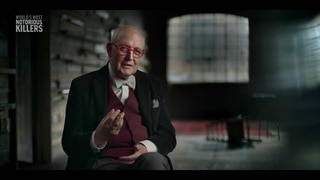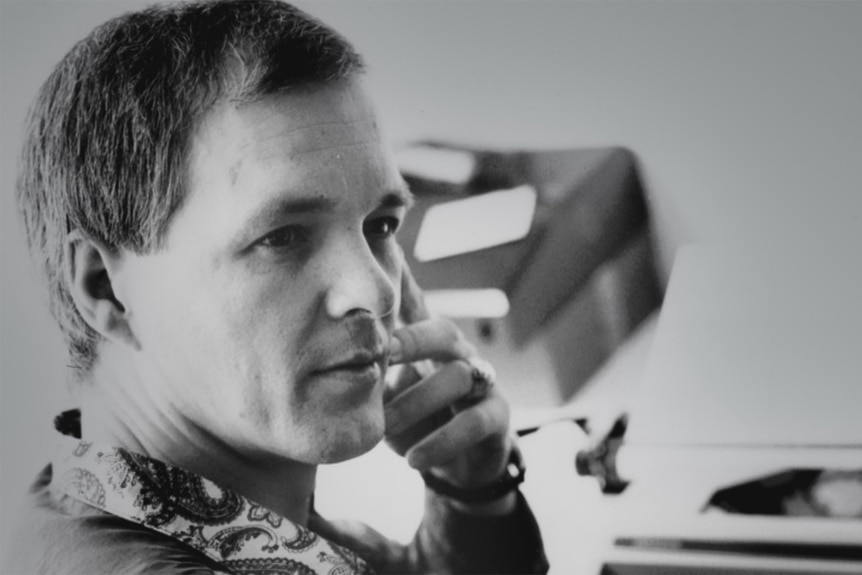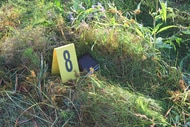Create a free profile to get unlimited access to exclusive videos, breaking news, sweepstakes, and more!
Jack Unterweger Passed Himself Off As a Reformed Criminal, Then Killed Many More Victims
Jack Unterweger was known as a reformed killer and respected crime journalist in Austria until it was discovered that he was reporting on his own horrific acts.
Popular Austrian crime journalist Jack Unterweger reported on some of that country’s most savage murders — but initially, no one suspected he was the one carrying out some of these brutal slayings.
Unterweger, who gained fame in the country as a “reformed” criminal turned poignant writer, used his respected cover to carry out multiple murders, including three in Los Angeles, often strangling the women he targeted on the streets with their bra and leaving their naked bodies hidden in the woods, according to Peacock’s World’s Most Notorious Killers.
The charismatic killer then covered the crimes for the media, securing interviews with top police officials about the very murders he carried out.
“He seemed to be a nice guy. I trusted him and this was my great mistake,” Max Edelbacher, former head of the special crime unit for the Vienna Police, said on the Peacock series' "The Vienna Strangler" episode.
Unterweger’s secret double life, filled with lavish parties with Austria’s elite, ultimately came to an end in 1992 after police linked him to nearly a dozen murders in Austria, Los Angeles and Prague and took him into custody in Miami, where he had gone on the run with his young girlfriend.
Who was Jack Unterweger?
Unterweger may have enjoyed a life of luxury after gaining notoriety in Austria, but he came into the world in 1950 under much less extravagant circumstances. His Austrian mother had an affair with an American soldier, his father, whom Unterweger never met.
“His mother too disappeared pretty soon and left him with Jack’s grandfather, a violent man,” Malte Herwig, author of Austrian Psycho: Jack Unterweger, told World's Most Notorious Killers.
Unterweger was then shuttled between foster homes and at the age of 16, began a life of crime, starting with small theft and graduating to robbery, car theft and fraud.
In 1974, his crimes escalated to murder after Unterweger and his girlfriend saw Margret Schäfer walking down the street and invited the 18-year-old to take a ride with them.
“Margret gets in the car and quickly the whole thing takes this very dark turn,” John Leake, author of Entering Hades: The Double Life of a Serial Killer, said on World's Most Notorious Killers.
According to Leake, Unterweger punched Schäfer in the face, tied her hands behind her back and drove to the woods, where he forced her to get out and marched her into the trees. His girlfriend at the time would later say that when Unterweger returned 10 minutes later, he came back alone and carrying a steel whip covered in blood and hair.
RELATED: Wrong Twin Suspected After Teacher Fatally Shot in Her Car and Clues First Point To Him
Why did Jack Unterweger get released from prison?
Unterweger was found guilty of Schäfer's murder two years later and sentenced to life behind bars in what Herwig described as the “toughest prison in Austria.” But his life took a surprising turn after he wrote an autobiographical novel about the crime while behind bars, titled Purgatory or the Trip to Jail: Report of a Guilty Man.
“He claimed that he was in a drug-addled state, he had unresolved issues with his mom who had repeatedly abandoned him,” Leake said. “That becomes Jack’s story that it was this kind of Freudian drama about his mom.”
The novel soon became a critical success and Unterweger became the “poster boy of criminal rehabilitation” with many of society’s elite, including Austrian novelist and playwright Elfriede Jelinek, calling for his release from prison.
He was granted a rare presidential pardon and was released in May of 1990, after serving just 15 years of his sentence. Unterweger immediately became a media sensation, hosting his own press conference just after his release and appearing on a popular talk show on the Austrian Broadcasting Corporation, wearing a distinctive white silk suit with a red carnation on his lapel, to talk about reducing the stigma surrounding those with criminal pasts.
Jack Unterweger’s victims
Cashing in on his popularity, Unterweger began working as a crime journalist, carrying out assignments for some of Austria’s top media outlets.
When women started disappearing from Vienna’s red light district, Unterweger got an assignment from a popular evening radio show to report on the killings. He interviewed Edelbacher, a top Vienna Police official, to get an update on the case.
“Unfortunately, it hasn’t been resolved successfully because despite many investigative efforts, we haven’t made any breakthroughs so far,” Edelbacher told him at the time.
Law enforcement officers in Vienna, which was historically a city with little crime, were baffled by what appeared to be a string of serial murders targeting sex workers. The body of Sabine Moitzi was found May 20, 1991 in the Vienna woods. She was naked, lying on her stomach with her legs spread wide.
“This was a very unusual crime scene,” recalled Ernst Geiger, head of homicide for the Vienna Police. “Usually, the offenders hide the bodies but, in this case, there were only some little branches on the body, but there were too few to hide the body.”
She had been strangled with her leotard and stockings, which were tied in a “special ligature” around her neck.
Just three days later, the naked body of Karin Eroglu was found in the woods under eerily similar circumstances. She had also been strangled with her own leotard. Rain had washed away any physical evidence that may have been left behind, giving investigators few clues to go on.
“In Vienna, we had no experience with serial killers, so we had no idea what was his motive,” Geiger told World's Most Notorious Killers.
Vienna Police also soon discovered the bodies of Regina Prem and Silvia Zagler.
As police investigated, Unterweger headed to Los Angeles for another radio assignment for the Austrian Broadcasting Corporation, exploring the darker side of the City of Angels. While there, he went on a ride-along with a Los Angeles Police Department officer and interviewed sex workers about the dangers of the streets.
“It’s ugly, it’s dirty, it’s scary, you could die every time you get in a car," one woman hauntingly told Unterweger in one of his interview recordings. "Every time you drive away, you don’t know if he’s going to kill you,”
Unterweger stayed in the famed Cecil Hotel — once a temporary home for serial killer Richard Ramirez — and just like in Vienna, sex workers in Los Angeles soon began to disappear.
Shannon Exley was the first to be found on June 20, 1991, followed by Irina Rodriguez and Sherri Ann Long. All the victims were strangled with their own bras by a killer who used what appeared to be the same signature knot.
“That unique behavior would make it logical to conclude we’re looking for a single offender, the same offender for all three,” said Gregg McCrary, who worked as a profiler in what was then the FBI's Behavioral Sciences Unit.
Los Angeles Police knew they were likely looking for a serial killer, but just as quickly as the killings started, they inexplicably stopped.
By then, Unterweger was back in Austria.
How Jack Unterweger was finally caught
Unterweger’s reign of terror finally came to an end after crime reporter Hans Breitegger began looking into the disappearance of sex workers from Graz, an Austrian city about 120 miles away from Vienna.
When the bodies of Brunhilde Masser and Elfriede Schrempf were discovered, it was determined they had been strangled with their own bras.
Breitegger became suspicious of Unterweger after looking into his past crime and discovering that his victim in 1974 had been beaten with a metal pole and strangled with her bra.
“For me, it was clear there’s a thread connecting all the crime scenes,” he said. “I was convinced we were on the right track. So, I informed the Graz Police.”
RELATED: Pennsylvania State Trooper Fatally Slashes Throat of Girlfriend's Estranged Husband
Police in Graz began canvassing the city’s red light district with a photo of Unterweger and found three sex workers who confirmed they’d seen him in the area. One woman even had a harrowing story about meeting a man driving a white Ford Mustang and wearing a white suit, matching Unterweger’s description, who'd told her he was a reporter, then took her into the woods and handcuffed her. But just as her terror mounted, he uncuffed her and drove her back into town.
“The story that she told exactly matched their hypothetical modus operandi and the killer in every respect except for the fact that he didn’t kill her,” Leake said.
Unterweger was also linked to the death of Blanka Bočková in Prague.
Just over a year after he was released from prison, he was now suspected of killing 11 more women.
The police in Graz obtained a search warrant and arrest warrant on February 14, 1992 for Unterweger, but he disappeared with his teen girlfriend Bianca Mrak before they could make an arrest. The pair fled to Miami and rented a room in South Beach, but were captured by U.S. Marshals two weeks later.
Jack Unterweger extradited to Austria
Unterweger was extradited back to Austria to face the murder charges against him. The high-profile trial in Graz, dubbed the “trial of the century” by Leake, began on April 20, 1994.
Prosecutors laid out the largely circumstantial case they had against him, using receipts they’d discovered during a search of his home to prove he was in each location the night of the killings.
McCrary took the stand to lay out the unique signature of using a bra to strangle the women that Unterweger used at most of the crime scenes.
The only physical evidence prosecutors had to link him to the crimes was a hair from Bočková found on the seat of a car he had scrapped.
“It was by no means an open and shut case,” Herwig said.
Many feared the persuasive Unterweger — who testified in his own defense — would charm the jury and avoid conviction.
“He put on an amazing performance,” Herwig said.
But it wouldn’t be enough. The jury voted to convict Unterweger on nine of the 11 murder counts against him in a 6-2 decision. In Austria, a verdict can be reached by having a majority, and doesn't need to be unanimous.
He was acquitted of two of the murders because the bodies had been so decomposed that it wasn’t possible to determine a cause of death.
Where is Jack Unterweger today?
Just hours after his conviction, Unterweger hanged himself in his cell using a thin cord from his sweatpants to tie around his own neck.
“Some people think the ligature with which he used to hang himself was in effect a confession,” Leake said of the unusual way he tied the knot, which was similar to the method used on the strangled sex workers.
Unterweger’s death took away any opportunity to study the charismatic killer any further.
“I was disappointed to learn that he had committed suicide because Jack was undoubtedly one of the most fascinating criminals I’ve dealt with,” McCrary said. “He’s typical of psychopathic offenders, but like on steroids. His organization, his ability to schmooze people, manipulate, control them (and) be above suspicion is a cut above.”
To learn more about Unterweger and other chilling international killers, tune in to Peacock’s World’s Most Notorious Killers, streaming now.

































